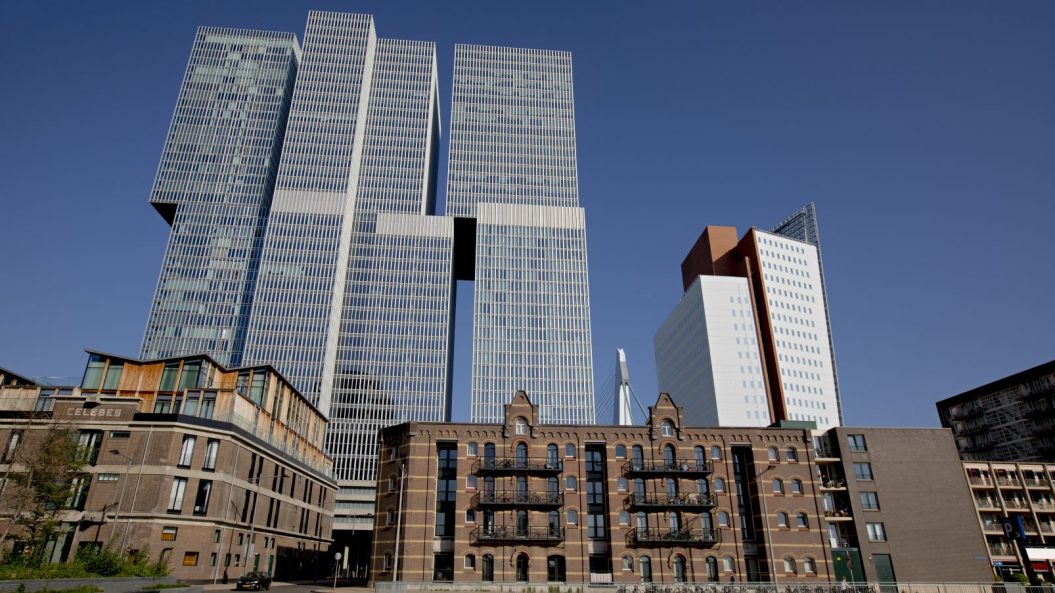As part of the deployment of the Digitale Stad (Digital City) project, the municipality of Rotterdam are exploring the opportunities and threats associated with digitalisation. 3D Digital Twin forms part of this project; a digital rendition of Rotterdam showing all fixed objects such as houses, trees and benches. Supplemented with data, this ‘city twin’ can provide valuable information. Which parking spaces are occupied? How long does the lamp in a lamp post keep burning?
In order to explore which smart applications will be feasible using this accumulation of data, the municipality of Rotterdam is working together with various partners, including Hogeschool Inholland. Students are going to apply themselves to this issue for six months, devising concepts that will make best use of the platform. The main theme pivots around sustainability and circularity (a zero-waste city).
Agriculture in the city
Three students, Tyeisha Felipa, Niels Abou Al Naser and Dewi Neleman, each worked out a different approach to the deployment of Digital Twin. Together with his fellow-students, Niels Abou Al Naser launched the idea of setting up an advisory bureau for agriculture in the city. Niels Abou Al Naser: ‘Using the Digital Twin algorithms, we can spot sites in the city that would be suitable for the cultivation of fruit and vegetables. Think in terms of roofs, buildings that would be suitable for housing a vertical garden, and kitchen gardens in which local residents can get together. All kinds of relevant information can be found using Digital Twin, for example, whether places have plenty of sunlight or are in shade, as well as the quarter-specific demand for products. Our advisory bureau can also provide information about circular farming. We can see which supermarkets and shops in the neighbourhood could sell the crops that might be grown, and we also know the sources of waste and the companies that could re-use such waste, e.g. coffee grounds that could be used as a substrate’.
A waste monster
Dewi Neleman devised an altogether different application for Digital Twin. Together with her small group, she turned her attention to children, the adults of the future. She put together a lesson package to make the younger generation aware of waste and circularity. Dewi Neleman: ‘We developed an interactive waste bin that can measure the amount of waste being thrown away. The waste bin visualises the volume in the form of a digital waste monster. The image of the monster is projected, and it grows as the amount of waste increases. The recycling of waste – for example, by using it to craft flower pots – reduces the size of the monster’.
Event locations on the map
Tyeisha Felipa also went to work with her fellow-students. Between them, they developed a solution for the events industry. Using the digital rendition of the city, event organisers can spot and map out likely locations. Tyeisha Felipa: ‘This is a handy tool for festival and events organisers; they can lay out a location digitally, for example, the position of a stage or Ferris wheel, or promotional stands for a trade fair. The parties involved in organising an international event no longer have to rush about in all directions looking for locations. You can also spot buildings that are vacant pending demolition using Digital Twin, as well as potential sites for events’.
Digital and physical
The students had to consider a combination of three factors: social, physical and digital. The linking of these elements is not always feasible. ‘This is especially so for the combination of the physical world and a digital environment’ says Tyeisha Felipa. ‘We have checked what happens if we digitise data from the physical world; something you can see happening in web shops. When you look at a product, it is projected onto the screen on your desk so that you can see its actual size straightaway. It works just like a Snapchat filter’.
Design Thinking
Hogeschool Inholland uses Design Thinking, a method that provides creative solutions to complicated problems, for these assignments. Dewi Neleman: ‘That is great fun. For starters, you move in all directions, engaging with people and chatting with the target group, as well as playing games to think up the most bizarre ideas. And we can present our results in any format we choose; it could be a report, but a video or infographic would be just as welcome. There are absolutely no limits to your imagination’.
Implementation in practice
Since the presentation to the municipality, Niels Abou Al Naser’s idea has attracted some interest. ‘We have been invited to present our concept to the municipal department responsible for circular economy and roofs’, says Niels Abou Al Naser. ‘They are going to check whether it can actually be implemented’.
